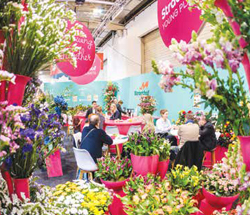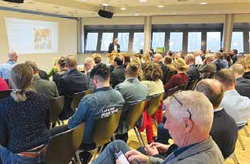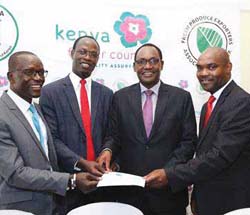
Reduction
The three R’s are a natural fit. We need to find the carbon footprint of what we are doing. This is the question where sustainability comes in, what is the environmental impact? Today’s market place; the millennials and the generation coming after, choose products based on their impact on the ecosystem. People purchasing today are using different parameters, whether you like it or not. “If you can identity and differentiate, your product from the guy next to you , as environmentally safe and ethically grown as well as meeting all other requirements for sustainability, then you’ll have a better leg to stand on,” Parit emphasized.
A lot of Carbon emissions is packaged per every kilo of flowers every year. This is where Kenya should put efforts to differentiate products and make them more competitive.

 “The joy that IPM ESSEN could finally take place again could be felt in every hall and at every stand”, Oliver P. Kuhrt, CEO of Messe Essen, sums up. The reunion of the green sector turned out to be more international than expected. Over 40,000 trade visitors from more than 100 countries came to Messe Essen to exchange information and to place orders. There was a wide range of products: 1,330 companies from 46 nations presented their innovations and new products in the fields of plants, technology, floristry and garden features from 24 to 27 January. Climate plants, environmentally friendly packaging and peat alternatives were particularly on trend.
“The joy that IPM ESSEN could finally take place again could be felt in every hall and at every stand”, Oliver P. Kuhrt, CEO of Messe Essen, sums up. The reunion of the green sector turned out to be more international than expected. Over 40,000 trade visitors from more than 100 countries came to Messe Essen to exchange information and to place orders. There was a wide range of products: 1,330 companies from 46 nations presented their innovations and new products in the fields of plants, technology, floristry and garden features from 24 to 27 January. Climate plants, environmentally friendly packaging and peat alternatives were particularly on trend. Leaf yellowing is symptomatic of a variety of problems, most of which can be pigeon-holed into four main categories that is, enviromechanical problems, nutrient deficiencies, pest damage, and disease damage. Its one of the symptoms that can be noted whenever a plant lacks or have had too much of something as it grows. When for example there is excessive fertilizer, irrigation, chemicals and nutrients the leaf tissues turn yellow whereby growth may become stunted. Other symptoms that go together with yellowing include reduced growth, scorched margins, fall of leaves and failure of blooms to open completely.
Leaf yellowing is symptomatic of a variety of problems, most of which can be pigeon-holed into four main categories that is, enviromechanical problems, nutrient deficiencies, pest damage, and disease damage. Its one of the symptoms that can be noted whenever a plant lacks or have had too much of something as it grows. When for example there is excessive fertilizer, irrigation, chemicals and nutrients the leaf tissues turn yellow whereby growth may become stunted. Other symptoms that go together with yellowing include reduced growth, scorched margins, fall of leaves and failure of blooms to open completely. Greenhouse engineering is an important carrier for the development of facility agriculture, as well as a “workshop” or workshop for the development of industrialization, intelligence and digitalization of agriculture. In the past 20 years, the development of greenhouse engineering from low to high level, from a single space to a comprehensive decoration, configuration, from simple to multi-functional power, from labour-intensive to machine generation, automatic control as the characteristics of technology-intensive, and so on, experienced a continuous development, continuous breakthrough, continuous improvement, keep pace with The Times, and the development of modern agriculture both adapt to each other and promote the process.
Greenhouse engineering is an important carrier for the development of facility agriculture, as well as a “workshop” or workshop for the development of industrialization, intelligence and digitalization of agriculture. In the past 20 years, the development of greenhouse engineering from low to high level, from a single space to a comprehensive decoration, configuration, from simple to multi-functional power, from labour-intensive to machine generation, automatic control as the characteristics of technology-intensive, and so on, experienced a continuous development, continuous breakthrough, continuous improvement, keep pace with The Times, and the development of modern agriculture both adapt to each other and promote the process. FSI members including flower producers, traders, and retailers gathered at IPM Essen for the General Assembly of 2023. To reflect on the Floriculture Sustainability Initiative’s 2022 achievements and actions to take towards a ‘responsible and transparent supply chain’. Besides the annual measurement of Responsibly Produced & Traded volumes, the members will start measuring and reporting on Carbon Footprinting and Living Wage. The year started off with a concrete action taken by the members: the FSI Code of Conduct was presented and adopted during the General Assembly. Members will embed this Code of Conduct in their policies and communicate it to their supply chain partners.
FSI members including flower producers, traders, and retailers gathered at IPM Essen for the General Assembly of 2023. To reflect on the Floriculture Sustainability Initiative’s 2022 achievements and actions to take towards a ‘responsible and transparent supply chain’. Besides the annual measurement of Responsibly Produced & Traded volumes, the members will start measuring and reporting on Carbon Footprinting and Living Wage. The year started off with a concrete action taken by the members: the FSI Code of Conduct was presented and adopted during the General Assembly. Members will embed this Code of Conduct in their policies and communicate it to their supply chain partners. Cut flower exporters in the country have raised concerns over increased water charges and payroll costs that have raised the cost of doing business, eroding their competitiveness.
Cut flower exporters in the country have raised concerns over increased water charges and payroll costs that have raised the cost of doing business, eroding their competitiveness. Reviewing 2022, there were several themes that emerged in the business world. This article highlights six top stories in the fresh produce sector in Kenya that made a significant impact on how the sector will perform and grow in 2023.
Reviewing 2022, there were several themes that emerged in the business world. This article highlights six top stories in the fresh produce sector in Kenya that made a significant impact on how the sector will perform and grow in 2023.